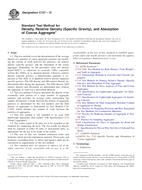Potřebujeme váš souhlas k využití jednotlivých dat, aby se vám mimo jiné mohly ukazovat informace týkající se vašich zájmů. Souhlas udělíte kliknutím na tlačítko „OK“.
ASTM C127-12
Standard Test Method for Density, Relative Density (Specific Gravity), and Absorption of Coarse Aggregate
Automaticky přeložený název:
Standardní zkušební metoda pro hustoty , relativní hustoty ( Specific Gravity ) , a absorpci hrubého kameniva
NORMA vydána dne 1.4.2012
Informace o normě:
Označení normy: ASTM C127-12
Poznámka: NEPLATNÁ
Datum vydání normy: 1.4.2012
Kód zboží: NS-10382
Počet stran: 6
Přibližná hmotnost: 18 g (0.04 liber)
Země: Americká technická norma
Kategorie: Technické normy ASTM
Anotace textu normy ASTM C127-12 :
Keywords:
absorption, aggregate, apparent density, apparent relative density, coarse aggregate, density, relative density, specific gravity , Relative density, Specific gravity--aggregates, Water absorption--aggregate/cement/concrete, Absorption--concrete/aggregates, Coarse aggregate, Compression and recovery, Density--paving materials, Immersion, ICS Number Code 91.100.30 (Concrete and concrete products)
Doplňující informace
| Significance and Use | ||||||||||||||||||||||||
|
Relative density (specific gravity) is the characteristic generally used for calculation of the volume occupied by the aggregate in various mixtures containing aggregate, including portland cement concrete, bituminous concrete, and other mixtures that are proportioned or analyzed on an absolute volume basis. Relative density (specific gravity) is also used in the computation of voids in aggregate in Test Method C29/C29M. Relative density (specific gravity) (SSD) is used if the aggregate is wet, that is, if its absorption has been satisfied. Conversely, the relative density (specific gravity) (OD) is used for computations when the aggregate is dry or assumed to be dry. Apparent density and apparent relative density (apparent specific gravity) pertain to the solid material making up the constituent particles not including the pore space within the particles which is accessible to water. Absorption values are used to calculate the change in the mass of an aggregate due to water absorbed in the pore spaces within the constituent particles, compared to the dry condition, when it is deemed that the aggregate has been in contact with water long enough to satisfy most of the absorption potential. The laboratory standard for absorption is that obtained after submerging dry aggregate for a prescribed period of time. Aggregates mined from below the water table commonly have a moisture content greater than the absorption determined by this test method, if used without opportunity to dry prior to use. Conversely, some aggregates which have not been continuously maintained in a moist condition until used are likely to contain an amount of absorbed moisture less than the 24-h soaked condition. For an aggregate that has been in contact with water and that has free moisture on the particle surfaces, the percentage of free moisture is determined by deducting the absorption from the total moisture content determined by Test Method C566. The general procedures described in this test method are suitable for determining the absorption of aggregates that have had conditioning other than the 24-h soak, such as boiling water or vacuum saturation. The values obtained for absorption by other test methods will be different than the values obtained by the prescribed soaking, as will the relative density (specific gravity) (SSD). |
||||||||||||||||||||||||
| 1. Scope | ||||||||||||||||||||||||
|
1.1 This test method covers the determination of the average density of a quantity of coarse aggregate particles (not including the volume of voids between the particles), the relative density (specific gravity), and the absorption of the coarse aggregate. Depending on the procedure used, the density (kg/m3 (lb/ft3)) is expressed as oven-dry (OD), saturated-surface-dry (SSD), or as apparent density. Likewise, relative density (specific gravity), a dimensionless quantity, is expressed as OD, SSD, or as apparent relative density (apparent specific gravity). The OD density and OD relative density are determined after drying the aggregate. The SSD density, SSD relative density, and absorption are determined after soaking the aggregate in water for a prescribed duration. 1.2 This test method is used to determine the density of the essentially solid portion of a large number of aggregate particles and provides an average value representing the sample. Distinction is made between the density of aggregate particles as determined by this test method, and the bulk density of aggregates as determined by Test Method C29/C29M, which includes the volume of voids between the particles of aggregates. 1.3 This test method is not intended to be used with lightweight aggregates that comply with Specification C332 Group I aggregates. 1.4 The values stated in SI units are to be regarded as the standard for conducting the tests. The test results for density shall be reported in either SI units or inch-pound units, as appropriate for the use to be made of the results. 1.5 The text of this test method references notes and footnotes which provide explanatory material. These notes and footnotes (excluding those in tables and figures) shall not be considered as requirements of this test method. 1.6 This standard does not purport to address all of the safety concerns, if any, associated with its use. It is the responsibility of the user of this standard to establish appropriate safety and health practices and determine the applicability of regulatory limitations prior to use. |
||||||||||||||||||||||||
| 2. Referenced Documents | ||||||||||||||||||||||||
|
Doporučujeme:
Aktualizace technických norem
Chcete mít jistotu, že používáte pouze platné technické normy?
Nabízíme Vám řešení, které Vám zajistí měsíční přehled o aktuálnosti norem, které používáte.
Chcete vědět více informací? Podívejte se na tuto stránku.




 Cookies
Cookies
